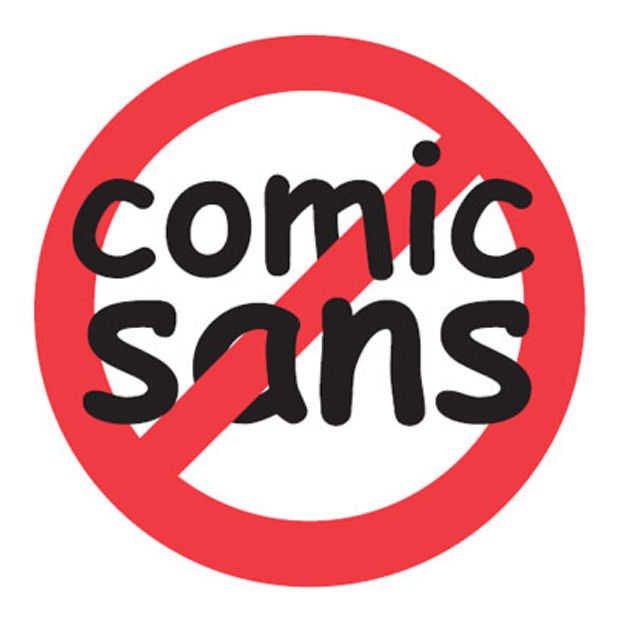When it comes to marketing, graphic design is of the utmost importance. Colors, shapes, and styles all have a psychological impact on how a brand is perceived. Branding, at its core, is a way to make a mental connection to a company in order to build customer loyalty and stand out against competitors. Because of the importance of branding, organizations take great care to create logos, styles, and graphics that represent the company’s ideals. Even the choice of font is imperative to branding. Studies have shown that people tend to correlate moods and personalities to different types of fonts. When branding a company, a business should certainly focus on projecting the image they desire, but one key component is often missed— function over form. A perfect example of this is the Comic Sans font.
Undeniably Hated by Nearly Everyone
 Comic Sans is a universally loathed font by marketers, designers, and consumers alike. It has consistently been considered one of the worst fonts available and the butt of many jokes since the font was created in 1994. The founder of the Ban Comic Sans Club described it as “a blight on the landscape of typography,” a sentiment that many share. There have been many discussions about why Comic Sans is such a despised font, but it essentially comes down to it having an aura of childishness. People perceive Comic Sans to be naive, playful, childlike, and silly. Despite this, though, Comic Sans has a surprising use: it seems to be easier to read for those with dyslexia.
Comic Sans is a universally loathed font by marketers, designers, and consumers alike. It has consistently been considered one of the worst fonts available and the butt of many jokes since the font was created in 1994. The founder of the Ban Comic Sans Club described it as “a blight on the landscape of typography,” a sentiment that many share. There have been many discussions about why Comic Sans is such a despised font, but it essentially comes down to it having an aura of childishness. People perceive Comic Sans to be naive, playful, childlike, and silly. Despite this, though, Comic Sans has a surprising use: it seems to be easier to read for those with dyslexia.
Surprisingly Useful for Dyslexics
 Dyslexia is the most common learning disability and it occurs in all areas of the world. It affects 3–7% of the population, but up to 20% of the general population may have some degree of symptoms. Dyslexia affects language comprehension in the brain and tends to be genetic. It involves reading difficulty caused by problems identifying speech sounds and how they relate to letters and words. There are different subtypes of dyslexia, with a combination of phonological and surface dyslexia appearing as often as 80% of people with dyslexia. Many people with dyslexia tend to transpose letters, numbers, or words. For example, “b” and “d”, “p” and “q”, or “n” and “u” may get swapped in a person’s brain, causing them to struggle with reading comprehension. We now have several fonts available (such as OpenDyslexic and Dyslexie) that are specifically designed for people with dyslexia, but they’re not universally available. Comic Sans, however, is available on nearly every platform anywhere in the world. There hasn’t been an official study on whether or not Comic Sans is truly easier for dyslexics to read, but many people with dyslexia state that it is. It’s speculated that the irregularity of the letters, the letter size, and the kerning make it easier for those with dyslexia to differentiate between letters & numbers that could be transposed.
Dyslexia is the most common learning disability and it occurs in all areas of the world. It affects 3–7% of the population, but up to 20% of the general population may have some degree of symptoms. Dyslexia affects language comprehension in the brain and tends to be genetic. It involves reading difficulty caused by problems identifying speech sounds and how they relate to letters and words. There are different subtypes of dyslexia, with a combination of phonological and surface dyslexia appearing as often as 80% of people with dyslexia. Many people with dyslexia tend to transpose letters, numbers, or words. For example, “b” and “d”, “p” and “q”, or “n” and “u” may get swapped in a person’s brain, causing them to struggle with reading comprehension. We now have several fonts available (such as OpenDyslexic and Dyslexie) that are specifically designed for people with dyslexia, but they’re not universally available. Comic Sans, however, is available on nearly every platform anywhere in the world. There hasn’t been an official study on whether or not Comic Sans is truly easier for dyslexics to read, but many people with dyslexia state that it is. It’s speculated that the irregularity of the letters, the letter size, and the kerning make it easier for those with dyslexia to differentiate between letters & numbers that could be transposed.
Empathy is Essential
 Using Comic Sans is an example of the importance of function over form, and even more so the role of empathy in marketing. If one were designing for a dyslexia-friendly brand, they may want to use Comic Sans as their primary website font. Even though just the thought of using Comic Sans makes most designers & marketers cringe to their core, the most important aspect of marketing is to serve the people who interact with that brand. Accessibility is very important in 2020, especially since COVID-19 has forced many people to shop and collaborate from home. Optimizing your website to be accessible not only opens your brand to another market but shows that your company truly cares for those with disabilities.
Using Comic Sans is an example of the importance of function over form, and even more so the role of empathy in marketing. If one were designing for a dyslexia-friendly brand, they may want to use Comic Sans as their primary website font. Even though just the thought of using Comic Sans makes most designers & marketers cringe to their core, the most important aspect of marketing is to serve the people who interact with that brand. Accessibility is very important in 2020, especially since COVID-19 has forced many people to shop and collaborate from home. Optimizing your website to be accessible not only opens your brand to another market but shows that your company truly cares for those with disabilities.
Are we suggesting that everyone should start using Comic Sans on their websites? No, of course not, but if your organization serves people with this disability it might be smart to put your feelings about the world’s ugliest font aside and think about the people you serve.



